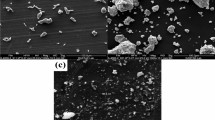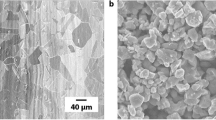The papers presents results of studies focusing on the development and characterization of ultrahigh-temperature structural ceramics, ceramics with high wear resistance and impact penetration resistance, and cermets and coatings based on nonoxide refractory compounds. The phase and structure formation of the materials is studied in interrelation with their mechanical and service properties. The materials are intended to perform as wear-resistant, shock-resistant, and structural parts (at temperatures above 1600°C in corrosive environments) for machines and units in various engineering fields.




Similar content being viewed by others
References
N. M. Rozhenko, V. V. Kartuzov, O. M. Grigor’ev, and L. M. Melakh, “Use of the ridge regression to study physical broadening of X-ray diffraction patterns,” in: Mathematical Models and Computational Experiment in Materials Science [in Russian], Issue 14, Kiev (2012), pp. 35–46.
B. A. Galanov, O. N. Grigor’ev, and E. G. Trunova, “Statistical characteristics of contact strength of ceramics,” in: Electron Microscopy and Strength of Materials [in Russian], No. 11, Inst. Probl. Materialoved. NAN Ukrainy, Kiev (2005), pp. 125–135.
B. A. Galanov, V. A. Kotenko, et al., “Contact strength and fracture toughness of brittle materials,” Metallofiz. Noveish. Tekhnol., No. 8, 1001–1018 (2005).
O. N. Grigor’ev, B. O. Galanov, V. A. Kotenko, and S. M. Ivanov, “Contact strength and mechanical properties of composite ceramic materials,” in: Fundamental Scientific Goals: Chemistry and Scientific Fundamentals of Prospective Technologies [in Ukrainian], Akademperiodika, Kiev (2005), pp. 304–326.
O. N. Grigor’ev, B. A. Galanov, V. A. Kotenko, and S. M. Ivanov, “Contact strength and fracture toughness of hard alloys,” in: Electron Microscopy and Strength of Materials [in Russian], Issue 13, Kiev (2006), pp. 43–54.
B. A. Galanov and O. N. Grigor’ev, “Analytical indentation model for brittle materials,” in: Electron Microscopy and Strength of Materials [in Russian], Issue 13, Kiev (2006), pp. 4–42.
B. A. Galanov and O. N. Grigor’ev, “Fracture criterion of composites with a ceramic matrix,” Probl. Prochn., No. 10, 30–40 (1993).
O. N. Grigor’ev, G. S. Krivoshei, and L. P. Khoroshun, “Internal stresses in composites based on silicon nitride,” Zavod. Lab., No. 10, 37–39 (1992).
O. N. Grigor’ev, A. Krell’, and V. I. Trefilov, “Determining internal thermal stresses in single-phase ceramic materials,” Zavod. Lab., No. 7, 36–39 (1990).
O. N. Grigor’ev and G. S. Krivoshei, “Determining thermal stresses in heterophase ceramic materials,” Zavod. Lab., No. 10, 30–32 (1992).
O. N. Grigoriev, S. M. Kushnerenko, K. A. Plotnikov, and W. Kreher, “Separation of internal strains and lattice distortion caused by oxygen impurities in aluminum nitride hot-pressed ceramics,” Adv. X-Ray Anal., 38, 479–487 (1995).
O. N. Grigoriev, Y. G. Gogotsi, V. I. Subbotin, and V. V. Kovalchuk, “Structure and properties of SiC–TiB2 ceramics,” J. Mater. Process. Manuf. Sci., 7, No. 1, 99–110 (1998).
O. N. Grigor’ev, A. V. Koroteev, and A. V. Klimenko, “Production and properties of multilayer SiC–TiB2 ceramics,” Ogneupory Tekh. Keram., No. 11, 20–25 (2000).
O. N. Grigoriev, A. V. Koroteev, A. V. Klimenko, and E. V. Prilutskiy, “Structure and strength of ceramic multilayered composites,” in: M.-I. Baraton and I. Uvarova (eds.), Functional Gradient Materials and Surface Layers Prepared by Fine Particle Technology, Kluwer Acad. Press, Dordrecht (2001), pp. 265–272.
O. N. Grigor’ev, G. A. Gogotsi, Yu. G. Gogotsi, and V. I. Subbotin, “Synthesis and properties of ceramics in the SiC–B4C–MeB2 system,” Powder Metall. Met. Ceram., 39, No. 5–6, 239–250 (2000).
Yu. G. Gogotsi and V. A. Lavrenko, Corrosion of High-performance Ceramics, Springer-Verlag, Berlin (1992), p. 181.
O. N. Grigoriev, B. A. Galanov, V. A. Lavrenko, et al., “Oxidation of ZrB2–SiC–ZrSi2 ceramics in oxygen,” J. Eur. Ceram. Soc., 30, 2397–2405 (2010).
V. I. Trefilov, O. N. Grigoriev, G. V. Trunov, et al., “Development of high-temperature ceramics for application in gas turbine engine components,” in: M. V. Roode, M. K. Ferber, and D. W. Richerson (eds.), Ceramic Gas Turbine Components Development and Characterization, Vol. 2, ISME Press, New York (2003), p. 775.
O. N. Grigoriev, B. A. Galanov, S. M. Ivanov, et al., “Mechanical properties of ZrB2–SiC–ZrSi2 ceramics,” J. Eur. Ceram. Soc., 30, 2173–2181 (2010).
B. A. Galanov, V. V. Kartuzov, and S. M. Ivanov, “New analytical model of expansion of spherical cavity in brittle material based on concepts of mechanics of compressible porous and powder materials,” Int. J. Impact Eng., 35, 1523–1528 (2008).
O. N. Grigor’ev, B. A. Galanov, A. V. Koroteev, etc., “Structure and penetration resistance of heterophase B4C–CaB6–TiB2 ceramics,” Dop. NAN Ukrainy, No. 10, 83–88 (2012).
O. N. Grigor’ev, B. A. Galanov, and V. A. Kotenko, “Resistance of B4C–VB2 composites in abrasive wear and friction in combination with steel,” Ogneupory Tekh. Keram., No. 10, 2–8 (2005).
O. N. Grigor’ev, T. V. Dubovik, O. D. Shcherbina, and N. D. Bega, “Sintered ceramics based on boron nitride and carbide,” Powder Metall. Met. Ceram., 46, No. 12, 46–50 (2007).
O. N. Grigor’ev, T. V. Dubovik, O. D. Shcherbina, and N. D. Bega, “Effect of ZrO2 and SiO2 additions on the phase formation and properties of hot-pressed composites based on boron carbonitride,” Ogneupory Tekh. Keram., No. 3, 18–26 (2009).
O. N. Grigor’ev, T. V. Dubovik, O. D. Shcherbina, and N. D. Bega, “Composites based on aluminum and boron nitrides formed during hot pressing,” Powder Metall. Met. Ceram., 48, No. 5–6, 346–352 (2009).
I. A. Podchernyaeva, A. D. Panasyuk, V. M. Panashenko, et al., “Electroerosion resistance and structural phase transformations in electrospark and laser deposition of titanium alloys using composite ceramics based on ZrB2–ZrSi2 and TiN–Cr3C2 systems,” Powder Metall. Met. Ceram., 47, No. 1–2, 116–123 (2008).
I. A. Podchernyaeva, A. D. Panasyuk, O. N. Grigor’ev, et al., Ukrainian Patent 82157, Composite Antifriction Heat-Resistant Material for Protective Coatings [in Ukrainian], Bulletin No. 5, Publ. March 11, 2008.
V. M. Panashenko, T. V. Mosina, and A. I. Dukhota, “Effect of ZrB2 on the tribological behavior of ceramic spark-deposited coatings,” in: R. V. Minakova et al. (eds.), Electrical Contacts and Electrodes (Collected Papers, Series: Composite, Layered, and Gradient Materials and Coatings) [in Russian], Inst. Probl. Materialoved. NAN Ukrainy, Kiev (2008), pp. 190–198.
I. A. Podchernyaeva, A. D. Panasyuk, and V. M. Panashenko, “Formation of the secondary structures on ZrB2-containing laser-spark coating on the titanium alloy during nonfixed-abrasive wear,” Dop. NAN Ukrainy, No. 9, 109–113 (2009).
I. A. Podchernyaeva, A. D. Panasyuk, O. N. Grigor’ev, and V. M. Panashenko, “Abrasive wear of ZrB2-containing spark-deposited and combined coatings on titanium alloy. I. microstructure and composition of ZrB2-containing coatings,” Powder Metall. Met. Ceram., 48, No. 5–6, 316–325 (2009).
I. A. Podchernyaeva, A. D. Panasyuk, O. N. Grigor’ev, and V. M. Panashenko, “Abrasive wear of ZrB2-containing spark-deposited and combined coatings on titanium alloy. II. Nonfixed-abrasive wear of ZrB2-containing coatings,” Powder Metall. Met. Ceram., 48, No. 7–8, 435–440 (2009).
I. A. Podchernyaeva, V. M. Panashenko, V. M. Vereshchaka, and G. S. Oleinik, “Fracture microstructure of laser-spark coating on titanium after abrasive wear,” Fiz. Khim. Mekh. Mater., No. 5, 107–112 (2009).
I. A. Podchernyaeva, A. D. Panasyuk, V. M. Panashenko, et al., Ukrainian Patent 89119, Ceramic Antifriction High-strength Material Based on Zirconium Diboride [in Ukrainian], Bulletin No. 24, Publ. December 25, 2009.
V. M. Panashenko, I. A. Podchernyaeva, A. D. Panasyuk, and D. V. Yurechko, “Electric mass transfer during electrospark deposition in the ceramic–ceramic system,” in: R. V. Minakova et al. (eds.), Electrical Contacts and Electrodes (Collected Papers, Series: Composite, Layered, and Gradient Materials and Coatings) [in Russian], Inst. Probl. Materialoved. NAN Ukrainy, Kiev (2010), pp. 160–171.
I. A. Podchernyaeva, A. I. Dukhota, V. M. Panasyuk, et al., “Kinetics and mechanism of fretting corrosion of spark-deposited and laser-spark ZrB2-containing coatings on VT3-1 alloys,” Probl. Tribol., No. 1, 62–71 (2012).
V. M. Panashenko, I. A. Podchernyaeva, A. I. Dukhota, and A. D. Panasyuk, “Structural and phase transformations on spark-laser coatings under fretting corrosion in air,” Powder Metall. Met. Ceram., 51, No. 1–2, 112–120 (2012).
A. G. Kostornov, A. D. Panasyuk, and I. A. Podchernyaeva, “Composite ceramic materials and coatings for tribological use,” Powder Metall. Met. Ceram., 42, No. 5–6, 249–256 (2003).
G. V. Samsonov, A. D. Panasyuk, and G. K. Kozina, “Contact reaction of refractory compounds with liquid metals,” Powder Metall. Met. Ceram., 11, No. 7, 568–571 (1972).
P. S. Kislyi, V. R. Maslennikova, B. L. Grabchuk, and A. D. Panasyuk, “Studying the adhesion of nickel alloys to boron carbide,” Adgez. Raspl. Paika Mater., Issue 2, 33–37 (1977).
A. D. Panasyuk, P. P. Pikuza, and I. P. Neshpor, “Contact interaction of silicon nitride and sialons with liquid silumins,” Adgez. Raspl. Paika Mater., Issue 15, 56–59 (1985).
A. D. Panasyuk, V. S. Fomenko, and G. G. Glebova, Resistance of Nonmetal Materials in Melts: Monograph Handbook [in Russian], Naukova Dumka, Kiev (1986), p. 312.
A. D. Panasyuk, A. P. Umanskii, and V. P. Smirnov, “Contact interaction of refractory compounds with Fe–Cr alloys,” Adgez. Raspl. Paika Mater., Issue 21, 78–83 (1988).
A. D. Panasyuk, A. G. Dovgan’, A. N. Vashchenko, and A. P. Umanskii, “Interaction of titanium and zirconium diborides with silicate melts,” Powder Metall. Met. Ceram., 27, No. 7, 580–584 (1988).
A. D. Panasyuk, L. I. Struk, A. I. Yuga, et al., “Tribological properties of nonmetallic nitride-base ceramic materials. I. Frictional characteristics of aluminum nitride-base composite materials,” Powder Metall. Met. Ceram., 29, No. 8, 655–659 (1990).
A. D. Panasyuk, A. P. Umanskii, and L. N. Beloborodov, “Interface interaction in (TiC–Mo2C)–(Ni–Mo) systems,” Adgez. Raspl. Paika Mater., Issue 26, 73–76 (1991).
A. D. Panasyuk, A. P. Umanskii, V. P. Konoval, and I. P. Neshpor, “Mechanisms of contact interaction between titanium–chromium carbide and Fe–Ni and Fe–Cr alloys,” Adgez. Raspl. Paika Mater., Issue 38, 51–58 (2005).
V. P. Konoval and V. A. Lavrenko, “Thermodynamics of interaction between refractory compounds and metal melts,” Powder Metall. Met. Ceram., 50, No. 3–4, 230–238 (2011).
A. D. Panasyuk, I. M. Spiridonova, and A. P. Umanskii, Stability of Composite Materials [in Russian], Svidler A.L., Dnepropetrovsk (2011), p. 244.
G. L. Zhunkovskii, T. M. Evtushok, P. V. Mazur, and V. A. Kotenko, “Interaction in the Ti–B4C system. I. Structurization of the formed composite,” Sverkhtverd. Mater., No. 1, 53–61 (2003).
G. L. Zhunkovskii, T. M. Evtushok, P. V. Mazur, and V. A. Kotenko, “Interaction in the Ti–B4C system. II. Optimization of the production and some mechanical characteristics of the composites,” Sverkhtverd. Mater., No. 2, 72–79 (2003).
T. M. Evtushok, A. D. Kostenko, O. N. Grigor’ev, et al., “Tribological properties of composite materials based on refractory titanium compounds,” Powder Metall. Met. Ceram., 44, No. 7–8, 353–357 (2005).
T. M. Evtushok, G. L. Zhunkovskii, and L. V. Strashinskaya, “Effect of titanium nitride on the tribotechnical properties of antifriction composite materials,” in: Refractory Nitrides and Materials on Their Basis [in Russian], Inst. Probl. Materialoved. NAN Ukrainy, Kiev (1992), pp. 184–190.
T. M. Evtushok, O. N. Grigor’ev, A. D. Kostenko, et al., “Composite materials based on titanium nitride for high-speed friction units,” Powder Metall. Met. Ceram.,. 45, No. 9–10, 445–447 (2006).
Author information
Authors and Affiliations
Corresponding author
Additional information
Translated from Poroshkovaya Metallurgiya, Vol. 51, No. 11–12 (488), pp. 100–116, 2012.
Rights and permissions
About this article
Cite this article
Grigor’ev, O.N. Ceramics and Cermets Based on Nonoxide Refractory Compounds. Powder Metall Met Ceram 51, 697–708 (2013). https://doi.org/10.1007/s11106-013-9485-y
Received:
Published:
Issue Date:
DOI: https://doi.org/10.1007/s11106-013-9485-y




